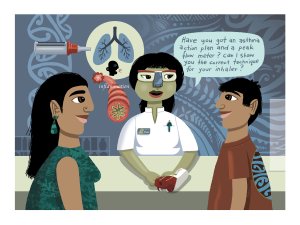Academic pharmacist Nataly Martini discusses the medical management of asthma in adults and adolescents, which has evolved to prioritise early anti-inflammatory treatment. She also explains how to improve patient outcomes by proactively identifying poor asthma control and supporting equitable access to education and treatment
Webinar: Practical management for patients with diabetes
Webinar: Practical management for patients with diabetes

This webinar provides an update on practical aspects of insulin therapy. It is the third in a series of webinars on the management of diabetes, brought to you with the support of Sanofi
This activity has been endorsed by the Pharmaceutical Society of New Zealand as suitable for inclusion in a pharmacist’s continuing education records for continuing professional development purposes. You can record details of this webinar on the “Keeping up to date” page of your portfolio on MyRecert (myrecert.pharmacycouncil.org.nz).
This webinar is presented by nurse practitioner Helen Snell and has the following learning objectives:
- List delays and barriers to insulin initiation and intensification
- Identify the potential for errors in insulin use by patients and healthcare providers
- Describe insulin delivery devices and correct technique when administering insulin
- Describe common complications associated with insulin use
After you have watched this presentation, you may complete the assessment below to test your understanding of the topic.
Remember, you can also use the Capture button below to record your time spent watching.
This is the third webinar in a series on the management of diabetes.
Watch the first webinar in this series: Update on interventions to improve glycaemic control in type 2 diabetes
Watch the second webinar in this series: Insulin therapy for patients with type 2 diabetes
Watch the fourth webinar in this series: Intensifying insulin therapy for people with type 2 diabetes
This 10-question multiple-choice assessment is designed to demonstrate that the webinar has been effective in allowing you to meet the learning objectives of this course. Write down your answers to these questions.
1. Which of the following are perceived barriers for CLINICIANS when initiating or intensifying insulin in their patients?
a. A belief the patient will be unwilling or unable to inject insulin
b. Complexity of insulin titration algorithms
c. Inability to teach a patient how to administer insulin correctly
d. Lack of knowledge of when insulin intensification is required
e. Not knowing enough about their patient’s fears, beliefs and expectations, which may then impact on the clinician–patient relationship
f. All of the above
2. Which of the following are perceived PATIENT barriers or delays to insulin initiation and intensification?
a. Concern about pain from injections
b. Concern about weight gain after starting insulin
c. Fear of hypoglycaemia
d. Lack of awareness of improved insulin delivery devices
e. The belief that insulin can cause limb loss or kidney failure
f. Treatment costs
g. All of the above
3. Which TWO of the following are potential patient errors when using insulin?
a. A 60kg woman injecting insulin into the triceps muscle with an 8mm needle at a 90 degree angle to the skin
b. A 75kg man injecting insulin into the abdomen with a 4mm needle at a 90 degree angle to the skin
c. After attaching a new insulin pen needle, priming the device until insulins squirts
d. Injecting insulin into a site 1.5mm from the umbilicus
e. Inverting the insulin pen cartridge before administering a premixed insulin
f. Using a HumaPen cartridge in a NovoPen 4
4. To avoid potential errors in insulin use, healthcare providers should do which TWO of the following?
a. Get familiar with the different-acting insulin preparations (short/intermediate, biphasic, mixed) to avoid confusion
b. Ensure the full brand names of insulins are clearly specified on prescriptions
c. Keep all insulins together on a single fridge shelf
d. Only stock either reusable or disposable insulin pens, but not both
e. Use the standard nomenclature of “U” for insulin units to avoid errors in prescription interpretation
5. Which TWO of the following statements about insulin delivery devices are correct?
a. Continuous subcutaneous insulin pumps deliver rapid-acting insulin only
b. Disposable insulin pens cannot be discarded in the recycling
c. Each branded reusable insulin pen must be matched with its complementary brand of insulin cartridge
d. Insulin syringes are recommended over pens only when there is a need to mix insulins together
e. Only people with type 1 diabetes can receive funded continuous subcutaneous insulin pumps
6. Select TWO responses that correctly complete the following sentence. When administering insulin:
a. into the abdomen, the injection should be ≥1cm above the symphysis pubis, ≥1cm below the lowest rib and ≥1cm away from the umbilicus
b. injection should be into a lifted skin fold
c. the abdomen is recommended over the thigh, as the rate of insulin absorption is faster and there is less risk of inappropriate needle placement
d. the device needle would usually be at a 45 degree angle to the skin
e. the needle or syringe should be of an appropriate length that ensures delivery into the intramuscular space
7. Lipohypertrophy is a common complication associated with insulin use. Which THREE of the following statements are CORRECT?
a. Absorption of insulin into sites of lipohypertrophy can lead to hyperglycaemia, unexpected hypoglycaemia or increased glucose variability
b. Inspection of injection sites for lipohypertrophy should be undertaken at least six-monthly
c. Lipohypertrophy can manifest clinically as induration of fat tissue
d. Lipohypertrophy can only be detected by visual inspection
e. Lipohypertrophy may develop from repeated injections into the same localised area
8. Which THREE of the following statements regarding hypoglycaemia and/or its treatment are CORRECT?
a. Glucagon should be injected into the subcutaneous space
b. Glucagon should not be given to someone with pheochromocytoma
c. Inability to concentrate is a symptom of mild to moderate hypoglycaemia only
d. Pallor and tremor can be symptoms of mild to moderate hypoglycaemia
e. The annual rate of severe hypoglycaemia in people with insulin-treated type 2 diabetes is about 2 per cent
f. Treatment of a severe hypoglycaemia event in a conscious person can be by oral administration of rapidly absorbed carbohydrate
9. Which THREE statements about people with diabetes taking insulin in specific situations such as driving and exercise are CORRECT?
a. Blood glucose levels should be tested before driving
b. Hypoglycaemia as a result of physical exercise occurs during the exercise period or directly afterwards
c. Most people rely on symptoms to detect hypoglycaemia while driving
d. Prolonged physical activity should be discouraged as it depletes glycogen stores
e. Should hypoglycaemia occur during driving, the driver should stop, treat the hypoglycaemia and wait one hour before driving again
f. When driving for long periods, blood glucose testing is not required as long as supplies of readily absorbed carbohydrates are available and consumed
10. Select THREE responses that correctly complete the following sentence. Acute illness that is not quickly and appropriately managed in people with diabetes taking insulin:
a. may put them at risk of a hyperosmolar hyperglycaemic state
b. requires rapid-acting insulin regardless of blood glucose levels if ketone levels are >0.6mmol/L
c. should prompt a rest period of at least four hours, then consideration of an insulin dose adjustment
d. should prompt a stop to all insulin and urgent contact with a healthcare practitioner
e. should prompt more frequent blood glucose testing
f. will always require an increase in insulin dose due to hyperglycaemia as a result of the illness
Write down your answers to these questions. Then, to check your answers and record your score, click here.






